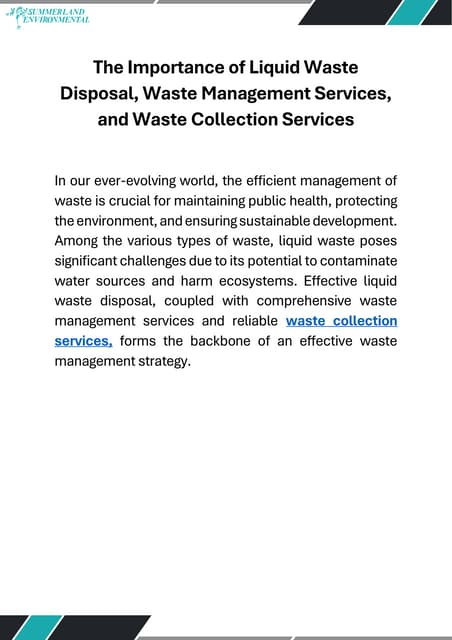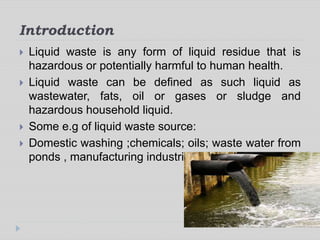The Best Strategy To Use For Reclaim Waste
Table of ContentsGetting My Reclaim Waste To WorkGetting The Reclaim Waste To WorkWhat Does Reclaim Waste Mean?Get This Report on Reclaim WasteReclaim Waste for Dummies
Explore the types, events, and types of liquid waste. Domestic sewer waste refers to the waste and items from a household septic container. This kind of waste is developed by people in homes, institutions, and other structures. This only consists of septic tanks that have a drainpipe field. The appropriate management and disposal of residential sewage waste require fluid waste to be moved to a sewer therapy plant where the appropriate methods and tools are applied to cleanse and throw away waste.
Business waste commonly includes prospective threats, such as combustible products or a mixture of liquid and strong waste products, and requires an extra sophisticated and detailed disposal process. The disposal of commercial waste commonly involves the filtering of waste before transportation to make certain secure and proper disposal. Industrial waste is developed from byproducts and overflow of commercial procedures and production.
This type of waste can not make use of the very same sewage monitoring transport or processes as septic or business fluids. The industrial waste management procedure requires the evaluation and screening of fluid waste before it undergoes the disposal process (industrial wastewater treatment). Runoff waste is the fluid waste that comes from drainage and excess stormwater in extremely inhabited locations or cities
Runoff waste can trigger contamination and flooding if not taken care of properly. Learn much more concerning sewer cleansing and waste monitoring. Making sure correct waste monitoring can protect against catastrophes and decrease environmental damage. Both individuals in property settings and experts in industrial or production industries can take advantage of understanding the procedures and laws of fluid waste monitoring.
The 5-Minute Rule for Reclaim Waste
Get in touch with PROS Solutions today to discover our waste monitoring and disposal services and the appropriate methods to care for the fluid waste you produce.
(https://writeablog.net/reclaimwaste1/reclaiming-resources-a-comprehensive-guide-to-industrial-wastewater-treatment)Do you understand what occurs to your water when you pull the plug, purge the bathroom or drain the cleaning machine? No? Well, it deserves understanding. This so-called 'wastewater' is not only an important source yet, after treatment, will be launched to our land, waterways or the ocean. Used water from commodes, showers, bathrooms, kitchen area sinks, laundries and commercial procedures is referred to as wastewater.

water used to cool equipment or clean plant and devices). Stormwater, a type of wastewater, is drainage that streams from agricultural and city locations such as roofs, parks, yards, roads, courses and rain gutters right into stormwater drains, after rainfall. Stormwater moves without treatment straight to local creeks or rivers, eventually getting to the sea.
All about Reclaim Waste
In Queensland, many wastewater is dealt with at sewage therapy plants. Wastewater is carried from residential or commercial sites via a system of drains and pump stations, called sewage reticulation, to a sewage therapy plant. City governments develop, keep and operate most sewage treatment plants. Operators are certified under the Environmental Security Act 1994 to discharge treated wastewater at an appropriate ecological standard right into waterways.
The Division of Natural Resources encourages local federal governments regarding managing, operating and preserving sewage systems and treatment plants. In unsewered areas, neighborhood governments might require homeowners to explanation set up individual or home sewer therapy systems to treat domestic wastewater from bathrooms, kitchens, restrooms and washings. The Division of Natural Resources authorizes the use of home systems when they are verified to be efficient.
In some new subdivisions, treatment of some stormwater to eliminate clutter, sand and crushed rock has begun making use of gross pollutant catches. Wastewater therapy happens in 4 phases: Eliminates strong matter.
Wastewater then flows right into large tanks where solids resolve and are gotten rid of as sludge. Oil and residue are skimmed from the surface area. Uses small living organisms understands as micro-organisms to damage down and eliminate remaining dissolved wastes and great bits. Micro-organisms and wastes are incorporated in the sludge. Gets rid of nitrogen and phosphorus nutrients that can trigger algal blooms in our waterways and threaten water life.
All about Reclaim Waste
Nutrient removal is not offered at all sewage treatment plants since it requires costly specialised equipment. Clear liquid effluent produced after treatment may still include disease-causing micro-organisms - liquid waste removal.

This normally suggests wastewater needs to be dealt with or impurities gotten rid of prior to it can be discharged to rivers. The majority of wastewater moves into the sewerage system. Under the Act, neighborhood federal governments carry out approvals and licences for ecologically relevant tasks (Periods) entailing wastewater launches that might have a local influence. The department administers authorizations and licences to Ages involving wastewater launches that may have a local or statewide effect.
The 7-Minute Rule for Reclaim Waste
Or else, samples are considered laboratory analysis. Frequently several examinations are required to develop the levels of each of the different pollutants such as oils, hefty steels and chemicals in water. Monitoring supplies valid information about water high quality and can validate that permit problems are being fulfilled. The information obtained with monitoring supplies the basis for making water high quality decisions.